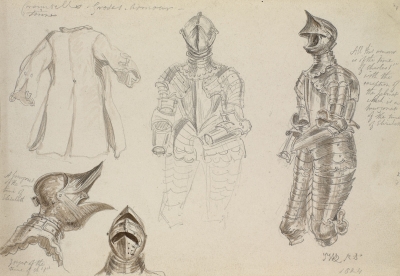This intricate sheet of studies was made by James Ward in 1824. The individual studies of armour are based on Francis Grose’s A treatise on ancient armour and weapons, illustrated by plates taken from the original armour in the tower of London, and other arsenals, museums, and cabinets, published in 1786. Grose records that all the helmets were in the collection of the Tower of London. The top three helmets (from left to right) are based on plate 5, nos. 1, 2 and 3. The three bottom helmets (from left to right) relate to plate 7, nos. 1 and 2 and plate 5, no. 4. The bottom left and centre helmets are ‘iron hats called pots, said to be taken from the French in the time of King Charles I.’ The bottom right helmet is shown sitting on a wooden stand in Grose’s illustration but Ward chose to depict it without, perhaps to make it more naturalistic. Ward made these studies in preparation for a great commission from Lord Northwick. Writing to his patron, the great collector Sir John Leicester, Ward reported in August 1824 Northwick:
‘has offered me 500 Guineas to paint him a Battle in the time of Cromwell, of the same size treated in any way I please — I like the thing mightily, there is variety of colour, stuffs, Leathers, armour, Beards, strong Horses, and other good matters at that period. There are also some broad brown hard faces — with rude expression &c &c but after all what has the little animal painter to do with all this combination of active Humanity.’
This sheet shows Ward’s evident delight in ‘the variety’ of seventeenth-century costume and armour and his determination to transform from the ‘little animal painter’ into an historical master.
The subject of the English Civil War held enormous appeal during the early decades of the nineteenth century not only in Britain, but also in France where historians such as François-René Chateubriand drew parallels with the French Revolution. In 1813 Sir Walter Scott published his Rokeby, a poem set in Yorkshire immediately after the Battle of Marston Moor. It was hugely successful with 10,000 copies sold within the first three months of publication. In 1831 J.M.W. Turner worked on illustrations to a revised edition of the poem with Scott and in the same year that Ward completed his canvas for Northwick Scott produced another Civil War work, Woodstock or the Cavalier: A Tale of the Year Sixteen Hundred and Fifty-one. In France the following year, Victor Hugo published his play, Cromwell and a decade later Paul Delaroche, who had become known for his paintings of English history, exhibited Charles I insulted by Cromwell’s Soldiers. He was still engaged by the subject over a decade later, when in 1849 he painted Cromwell before the coffin of Charles I, a subject which was also handled by Eugène Delacroix.
Ward’s commission from Lord Northwick therefore gave Ward the opportunity to handle not only a major historical subject, but one that was at the height of popularity amongst contemporaries. Ward in fact exhibited two paintings with Civil War subjects at the Royal Academy: The Battle near Boston, in 1826 and The Discomfiture of Charles II at Worcester, 1847. The present drawing gives an extraordinary insight into Ward’s scrupulous working methods as he prepared to become a serious historical painter. He went to great lengths to ensure historical accuracy.


